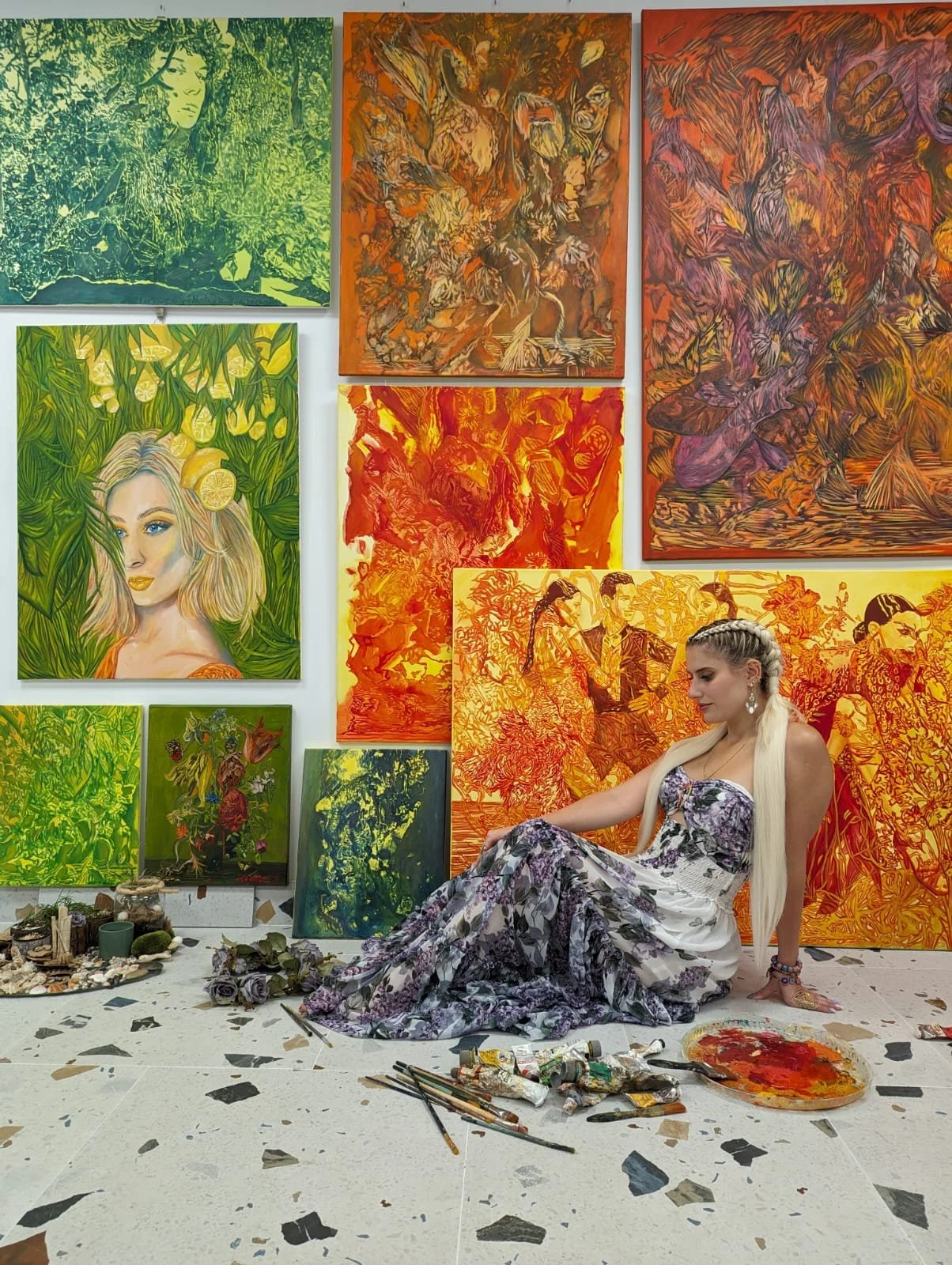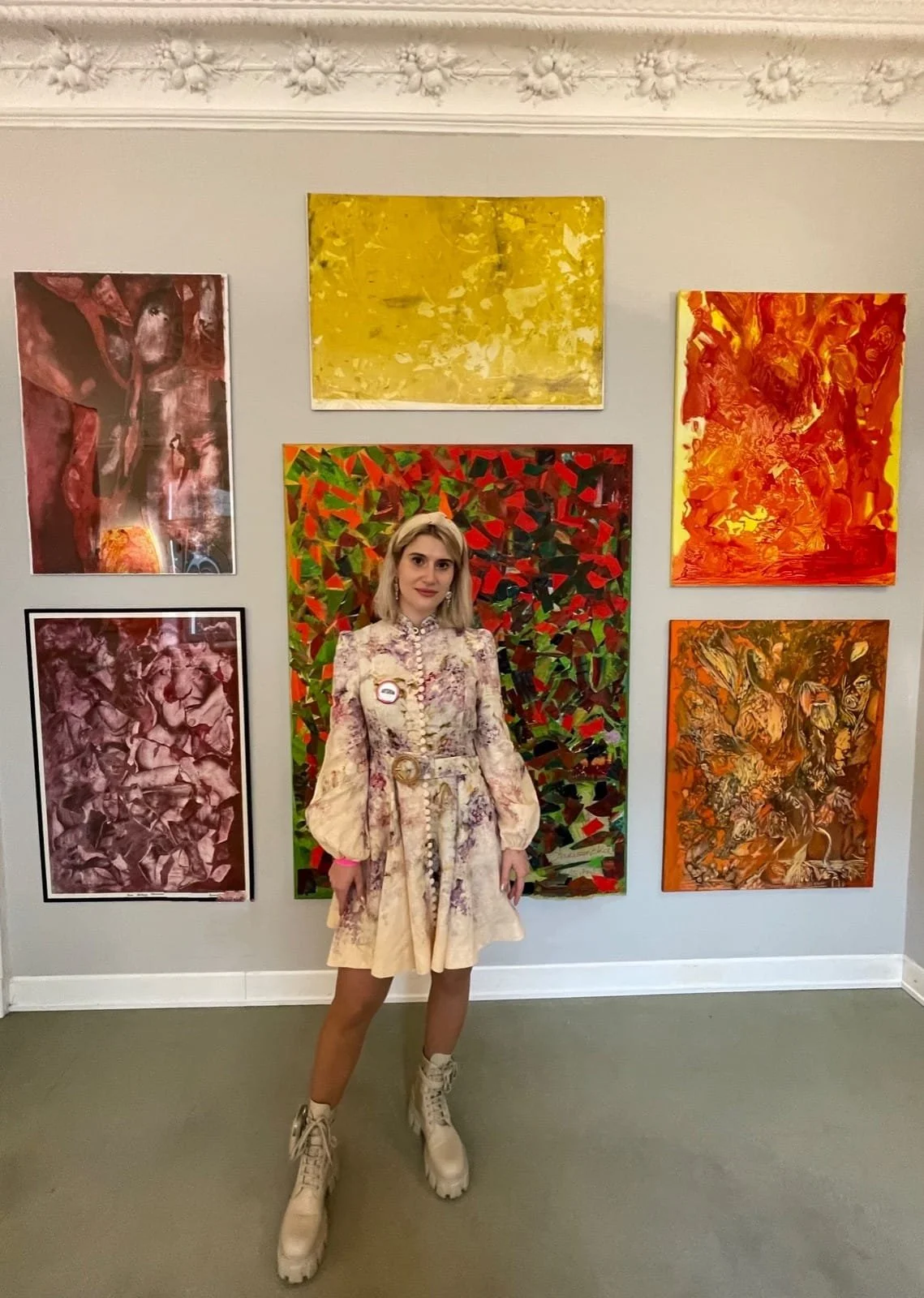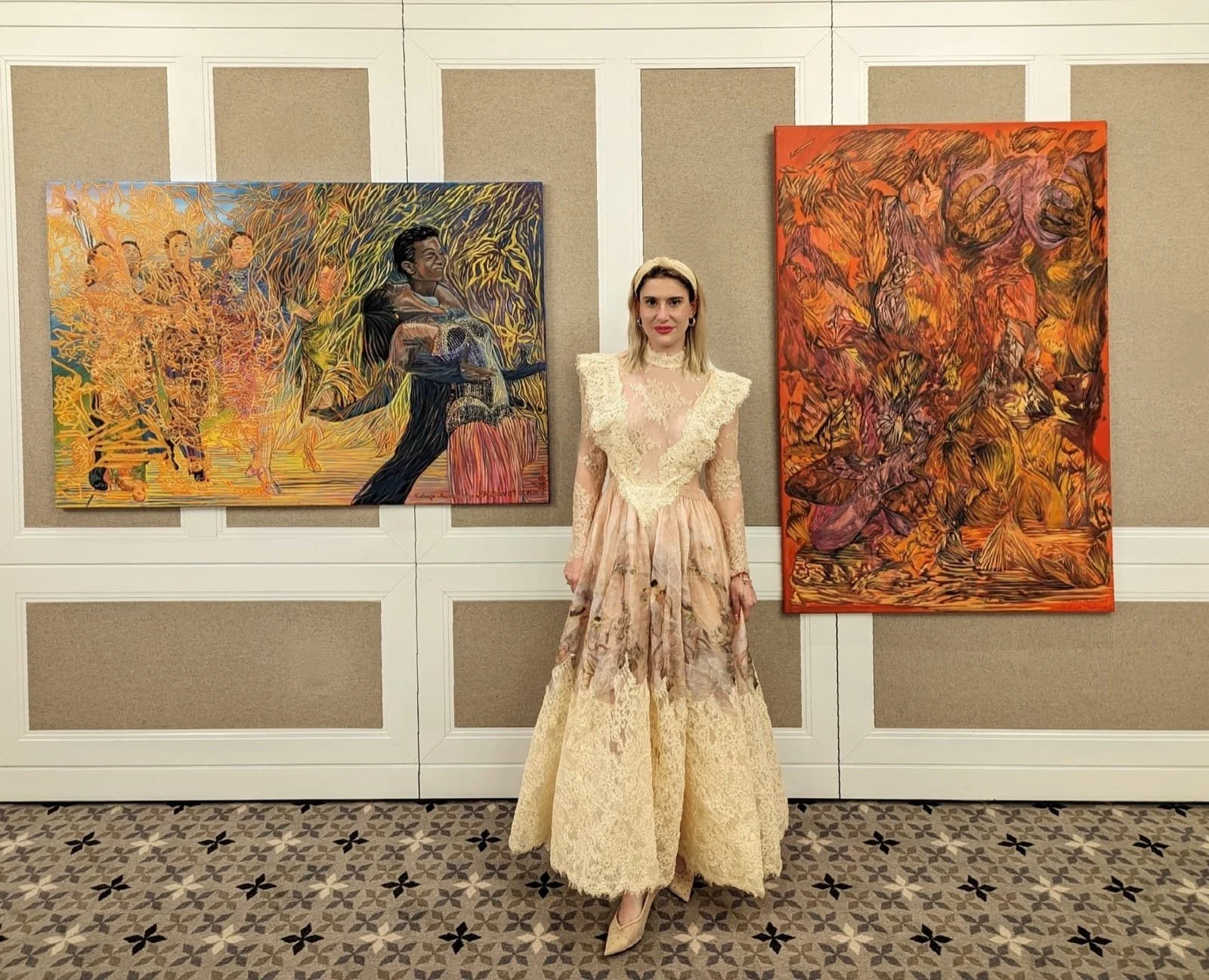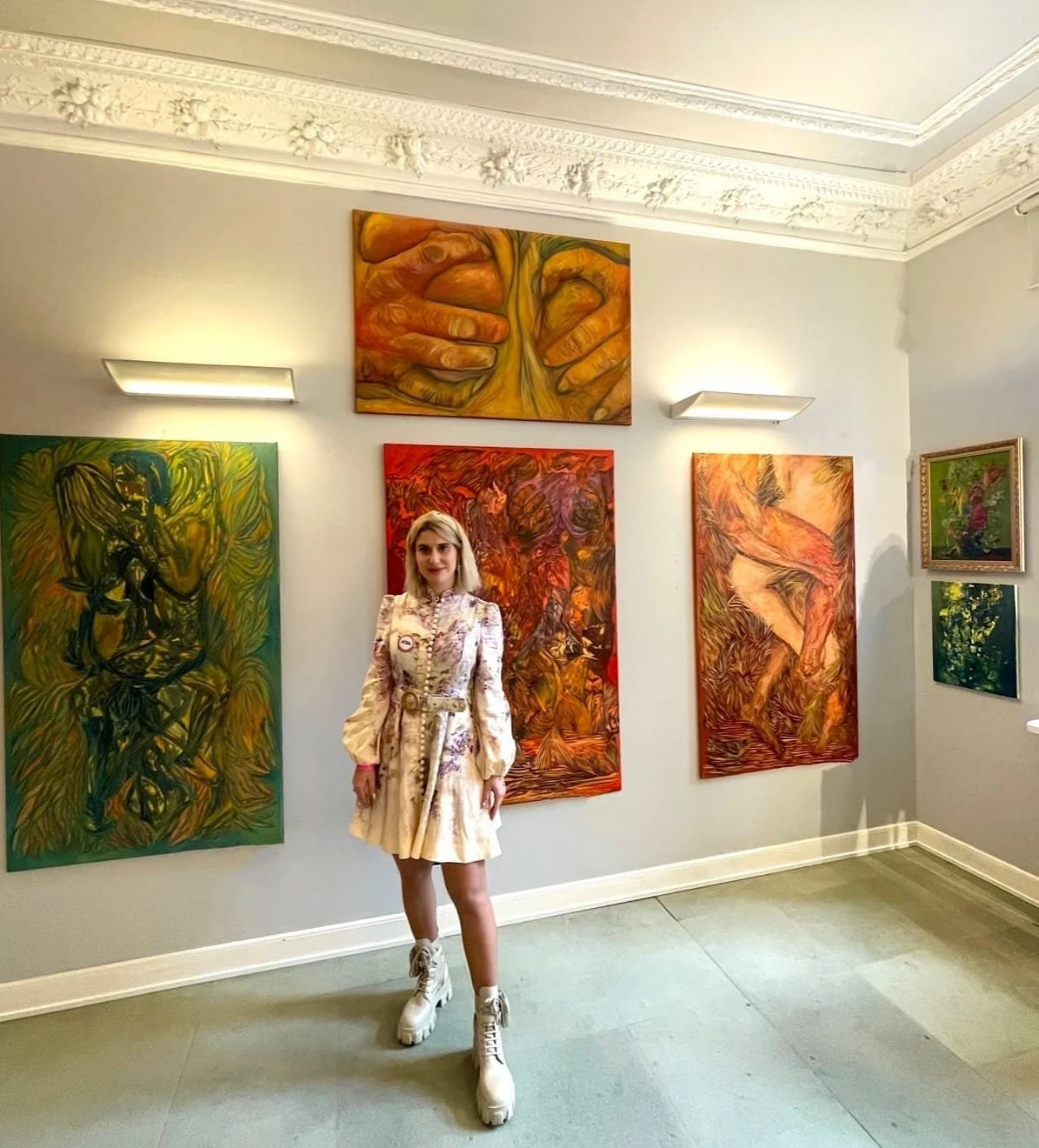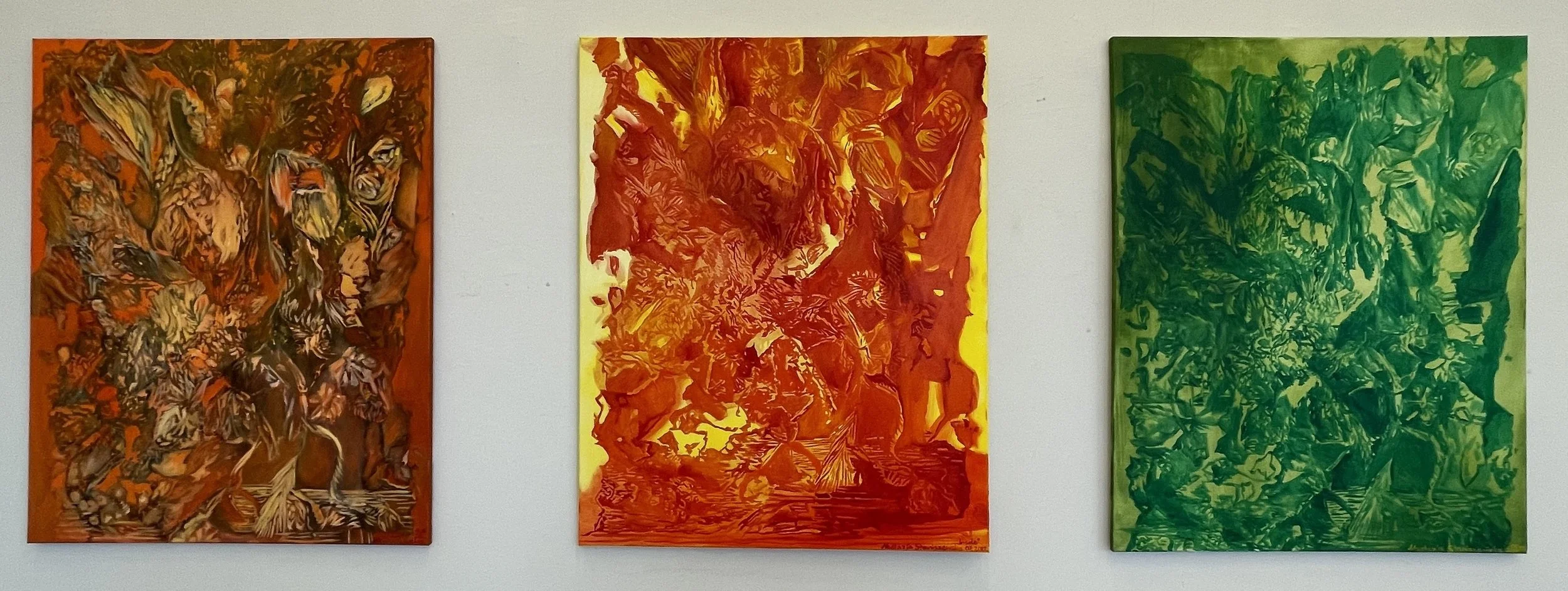Interview with Nastazja Staniszewska
Nastazja Staniszewska is a Polish artist born on February 10th, 1996 in Wroclaw, Poland. She studied Painting and Artistic Education at the Academy of Fine Arts Jan Matejko in Cracow, and later defended her doctorate in Painting at the Academy of Fine Arts Eugeniusz Geppert in Wroclaw.
Throughout her career, she has been a recipient of multiple scholarships from the rectors of the Cracow and Wrocław Academy of Fine Arts, in recognition of her artistic achievements. She has also participated in numerous individual and collective exhibitions both in Poland and abroad. Some of the notable exhibitions she has participated in include DRAWING TRIENNALE 2022 Wrocław, the exhibition "Positivist Time" at the Maria Konopnicka Museum in Żarnowiec, Art Fair "BODY SPACES" and "VISIONS" in Venice at the Albrizzi-Capello Palace, Art Fair in Rome in Medina Art Gallery, "SUPERNATURAL" in London at THE LINE Contemporary Art Space, the exhibition „Interconnecting lines” at the One Art Space in New York, Art Basel week in Basel, exhibition in Rome at the La Pagina Gallery at the Palazzo Maffei Marescotti, OPEN ART exhibition in Barcelona and Biennale Power of Woman in Art in Chelsea, Old Town, London.
Staniszewska's paintings can be found in numerous private collections throughout Poland and abroad, including Germany, the UK, Italy and USA. She primarily works with painting, but also engages in graphic arts such as rotogravure, monotype, and sculpture. Her art studio is located in the center of Wrocław, Poland.
In addition to her art, Staniszewska is also a published poet. In 2018, she published a book of poetry titled "Reflexion," which was featured in an article in the Psychological Magazine "Characters" in February 2019.
Having studied under several esteemed professors at different academies of fine arts across Poland, could you describe how each educational experience and mentor has shaped your artistic philosophy and techniques? Specifically, how have these varied academic environments contributed to the development of your distinctive style?
At the beginning of my creative path, I was inspired by artists such as: Frida Kahlo, Marina Abramovic, Alina Szapocznikow, Jenny Saville and Lucian Freud. I also find the work of our Polish painters worthy of attention: Katarzyna Kukuła and Agata Kus-Dymna, whom I had the pleasure of meeting personally during my studies at the Jan Matejko Academy of Fine Arts in Cracow. When I was creating under the influence of Cracow, my paintings were mostly realistic. Sometimes, when I gave vent to my emotions, I created a few works closer to the expressionist trend. At that time, I touched on topics mainly related to the negative aspects of human existence. My thoughts revolved around trauma and its side effects. The theme of my paintings refers to the medieval saying "Memento mori" (from Lat. Remember death)During my few years of studies at the Academy of Fine Arts in Cracow, many changes occurred in my life. First of all, I continued to attend therapy, which resulted in my health improving. I learned to believe in my own abilities, thus accepting my weaknesses. I understood that only when I learned to appreciate myself, and not just criticize, would I be able to fully devote myself to my love, which in my case is my passion for painting. "And here is my secret, it’s very simple: It’s only with the heart that one can see rightly, what is essential is invisible to the eye." A.d.Saint-Exupéry
In 2021, I decided to continue my adventure with painting at the Eugeniusz Geppert Academy of Fine Arts in Wroclaw, as a newer, healthier version of myself. My paintings then gradually began to take on more vivid, positive colors. This is clearly visible in the painting series, which is a triptych entitled "Flora Botanica". The triptych was created at the turn of 2021-2022. It was made in the following technique: acrylic, oil on canvas. Each painting has individual dimensions: 100 x 80 cm, which in its entirety creates a composition with dimensions: 100 x 240 cm. The paintings tell a story about positive post-traumatic development. The interiors of each work contain structures of corporeality, expressed through a composition made up of all kinds of vegetation, which in both the spiritual - mystical and physical - real world, express three painterly stories, which are built using hidden symbols: plants, insects, shapes. The main, dominant color in each of the paintings plays an important role here, because it is this that gives meaning to the entire representation: green, orange and red.The greatest influence on changing my perception of the painting, and thanks to this, the transition to expressing myself more emotionally than in the past, literally, realistically, was work in my mind, and when my supervisor supported my new visions, my head was opened to new painting possibilities. During my studies, I mainly created in solitude with my beloved Cavalier King Charles Spaniel, in my own art studio. I isolated myself from the university environment. Such an atmosphere was most conducive to my creativity.
The previously unknown structures of painting fascinated me, becoming the subject of my current research. Paintings that were once dark, sad, gloomy, were transformed into bold, lively, colorful representations, mainly oscillating around colors such as reds, yellows, and greens. An example of such paintings is the Triptych "Tangled in Grass", which tells the story of a true love, the search for light in one's own life and the bond with Mother of Nature.
My paintings are still inspired by the work of the exceptional Frida Kahlo. In her paintings, the artist clearly emphasizes the bond with nature and tells about trauma and its effects.
Your career features a notable presence in international art scenes, including exhibitions in New York, Barcelona, Basel, Italy, and London. How do these diverse cultural platforms influence the reception of your work? Do you find that the cultural context of each city alters the interpretation or appreciation of your art?
Yes of course the cultural context of each city alters the appreciation of my art f.ex. to paint the latest series of paintings for the Biennale Power of Woman in Art, Chelsea, Old Town in London 2024, I was inspired by the events and the beauty of Antoni Gaudi's architecture in Barcelona during the last exhibition in which I had the honor of presenting my paintings from the series "Flora Botanica". Inspired by the beauty of the virtuoso, brilliant architecture, the unusual combination of colors and the extravagant lifestyle of the inhabitants of Barcelona, I painted the painting: Untitled, after Frida Kahlos self portrait from 1948, 80 x 100 cm, oil on canvas. The inspiration for the creation of the painting was the "Self -portrait in the Tehuan headgear" by Frida Kahlo from 1948, which she worked to satisfy her life partner Diego Rivera. At that time, the artist was sick a lot, so it was the only painting she managed to paint in that year. I decided to refer to this art work because I feel a huge bond with it. A seemingly lace headgear is decorated Frida's face, but in fact she's involved in it. The artist's face disappears in density. Decorations are only used to distract the viewer from the problems that Kahlo has transformed traumatic experiences and her exceptional sensitivity to the unique language of art, which to this day inspires and encourages reflection on the meaning and goal of human existence. Also like Kahlo, I treated painting as a kind of art therapy I experienced a positive post-destroying development myself. My art work emanates spirituality, which gives me extraordinary strength to go forward despite adversity.I was also inspired by the architecture of Antoni Gaudí, and more precisely the stained glass and mosaics of his authorship, which I had the pleasure to admire live, during my last stay in Barcelona. I visited then: the famous temple of Sagrada Familia, artist's house Casa Milà, Casa Batlló residential building and the extraordinary Güell Park. Virtuoso, brave, and at the same time full of colors and various shapes of the famous architect, it is impossible not to admire! I am also inspired by nature and I believe that every color has power.
Next I created the painting „A woman in a ball gown and a mask”, 80 x 100 cm, oil on canvas, 2024. Since I can remember, nature inspired me a lot. The inspiration for the creation of the painting was primarily flowers and their unique structure, which I discover while walking in Park Güell in Barcelona. Unique roses allowed me to give a ball dress an incredible shape. I covered face with a mask made of pearls and golden thread, so that the secret would remain, who is behind the mask. The colors of the dress were inspired by the phenomenal portrait of "Romana de la Salle" by Tamara Łempicka from 1928. I had the pleasure of browsing through the book with T. Łempicka's paintings in La Casa Milà, Antoni Gaudi’s home.
Every exhibition in New York, Basel, London, Barcelona, Rome, Venice, Milano, every trip to another city, every event, participation in an exhibition inspires me. New, unique visions arise in my head, which I write down and sketch during my trips to exhibitions all around the World. Then I transfer my visions to canvas after returning to my art studio in Wrocław. Although I live and come from Poland, I would not describe my art as Polish at all. Honestly, my work has been much more accepted abroad, I think because of the choice of colours. My paintings are vivid, filled with colour, and in Poland the trend of realistic painting dominates, and the topics discussed are traumatic, difficult and depressing. On the other hand, due to the trauma I experienced due to an accident and personal problems, I decided that I didn’t want to paint depression. That is why I changed the place of my work from Cracow to Wroclaw. In Cracow, I didn’t feel understood. In Wroclaw, I found support for my colorful visions. I love immersing myself in my own world of imagination. I decided to give people positive energy through my paintings, because I believe that such paintings have it. I tore up and burned the negative, sad paintings from my old creative period, I couldn't be with them and I didn't have the heart to give them to others as their own. I believe that everything around us has energy. I also believe in the power of creation because my life has changed 180 degrees. In the Middle Ages they would have called me a witch.
Reflecting on your extensive list of artistic achievements and recognitions, which accolade or exhibition has been the most significant to you personally and why? How do these milestones align with your career aspirations and artistic vision?
I think that every achievement was equally important to me. Once, an exhibition in the corridor of the Academy of Fine Arts building stirred up a lot of emotions in me, but as my work developed, I began to take part in exhibitions in Museums, Art Fairs, and the Biennale in Poland. However, it turned out that exhibiting in Poland was not enough for me, I believe that for some reason my vision does not fully fit into Polishness, art museums consider my paintings to be too colourful in a critical way. Interestingly, when Poland did not fully agree with the vision of my painting, a gallery from New York wrote to me saying that they would like to present me. Then other galleries from Spain, London and Italy contacted me. Even a gallery from Vienna wrote to me that they would like to present my painting: „Catching in flowers” and „PASSION II” during the famous week of Art Biennale Basel in Basel Switzerland. Recently Van Gogh Gallery from Madrid contacted me. These are particularly nice moments for me, because the feeling that Your hard work is appreciated is, I think, extremely important for every artist. History wrote itself. However, I believe that in my art work this is only the beginning. My dream is for auction houses such as Sotheby's and Christies to notice my paintings and consider it extremely valuable, which is why I paint every day and I believe that one day my dream will come true. I love museums, I could live in them. Sometimes I visualize my painting ending up in such extraordinary places as the Tate Modern in London or the Albertina Modern in Vienna.
Your work often explores the themes of positive post-traumatic growth and the symbiosis between the human body and nature. Could you expand on the philosophical or psychological theories that inspire these themes? How do they manifest in your choice of subjects and techniques?
Everything changed for me in 2013. Since that once incident, I have been struggling with permanent pain caused by damage to my spine and neck. In addition, I have struggled with depression and anxiety disorders for several years.
I was walking with my friends when the driver lost control of the bike and jumped off, directing the machine towards me. As a result of the collision, my spine and hip got injured, my neck was damaged… I was in shock, and before my brain realized what had happened, I lost consciousness.
One day, while browsing the Internet, I typed “How to live with pain” into Google. Then, by chance, I came across a painting of Frida Kahlo by Magdalena Carmen entitled. “Broken column” from 1944. When I got to know the story of this injured and at the same time brave woman who never gave up despite adversity, I decided to be like her.
I didn’t expect to experience moments similar to those Frida did! When I left the hospital, I already knew that I didn’t want to go to law school, but to the Academy of Fine Arts. I wanted to be a painter like Kahlo. Thanks to this event I found a new purpose in life, to which I decided to devote myself to. However, after the accident, searching for myself and my place in the world was not easy for me. I frequently experienced depression and had a suicide attempt in 2017, from which I was rescued by a random passerby. So it wasn’t too colourful, but luckily I came out of it. My painting is very personal. It focuses mainly on the emotional aspect, a bit shamanic, spiritual and mystical. It gives a glimpse into the duality of the world; not zero-one, but one in which everything flows into everything. What comes from the human body into what comes from nature. Male into female. Sadness into joy. Loneliness into live. Trauma into positive post-traumatic development. The spaces of the body and nature symbolize the spiritual spheres. The energetic connections of bonds, which have been included in my paintings with the help of a brush and paint, are very important here. The whole story revolves around positive post-traumatic growth which I know from autopsy.
I mainly paint oil on canvas, in addition I create workshop graphics, sometimes sculpt and write poems. It’s really hard for me to express myself in one technique. Sometimes I also do the performance. I think that this is caused by my hypersensitivity to the perception of the world around us, which makes it difficult to express myself with one materia.
You've described your art as a personal diary that captures the emotional and spiritual duality of the world. What message do you hope your audience takes away from your art? Is there a particular piece that encapsulates this message most vividly for you?
The main goal in my art work is to search for a new form of representation in showing the structure of the body. The structures of corporeality are emotional and energetic forms that intertwine with the world around us, constituting a unity with it. Spirituality is very important to me. I believe that what is outside affects the inside, and our emotions directly affect the physical and mental health of our body. In addition, the images are a metaphorical story about the positive post-traumatic development that I experienced firsthand. With the development of my soul, my painting has undergone a significant transformation.
I want my art work to encourage reflection on the emotions that accumulate in the body and human existence, which is inseparably connected with the entire color palette of emotions.
In my works, I tell about what is honest, authentic, what I experienced firsthand, about the trauma I came out of. I honestly talk about what I think and feel and how I perceive the reality that surrounds us.
Each of my paintings contains a message about a positive post-traumatic development, the beauty of life, nature and the world around us. My paintings raise topics about the uniqueness of the gift which is LIFE.
Color plays a crucial role in your artwork, with each hue adding depth to the narratives you create. How do you choose your color palette, and what are some of the recurring symbols or motifs in your work? How do they contribute to the storytelling elements of your art?
The colors that appear in my paintings depend on the colors of my life. In a difficult period in which I fought with the effects of the accident and the trauma I created gray, black, blue paintings with a gloomy color tone. At the time I started to feel better with myself thanks to therapy and newly met friends during my studies at the Academy of Fine Arts, I began to use more colors such as ochra, siena, umbra, greens, and blues. When I fell in love and met my husband , on my painting palette joined: red, rose, orange and yellow.
Green symbolizes healing and hope. This color increases our sensitivity and balances the flow of energy in our body. This is evidenced by the fact that often, when we are stressed, we go for a walk to a nearby park or forest to breathe fresh air.
The soothing influence of nature helps us gather our thoughts. After such a walk, we return to continue our work in full harmony, with open heads, because the nervous system has been calmed down and our blood pressure has decreased. Then we become open to new possibilities that we didn’t notice before. In the Bible, green is the color of the Garden of the Lord.
Orange is obtained by mixing yellow and red. It’s known for its stimulating effect on the human mind, because it adds positive, creative energy.
The color red is primarily associated with passionate love. It also has many more meanings. It is the color of the basic human chakra, the color of strength, bravery, fortitude. With too much intensity, it can cause aggression.
Blue is one of the most spiritual colors in our lives. It evokes the elements of nature, such as air and water. It brings peace, freshness and dynamism to our mind, bringing with it new, creative inspirations.
Yellow is the color of light and the highest values, and they are different for each of us, so I leave the rest of the argument about colors for reflection…
In 2018, you published a book of poetry titled 'REFLEXION,' discussing personal trauma and human existence. How does this interplay between your visual art and written word affect your overall creative output? How has engaging with the public through these mediums influenced your artistic journey?
From book of poetry titled "Reflexion" in 2018 it all began. After the accident, I started writing poems to give an outlet to emotions and give my thoughts something sensible during an almost one year old hospital. It was the most difficult time in my life. There I started going to art therapy classes for victims after accidents. I slowly discovered the passion for painting. I opened fully on painting on canvas only after the proliferation of poetry volume. Then I tried my hand in the spatial matter which is the sculpture and in workshop graphics, reflected with the help of a concave press, which from my perspective is a technique that gives greater possibilities than the drawing itself with a pencil or a charcoal. I wanted to get to know all the techniques to choose the closest to my heart, which turned out to be the most traditional - oil painting on canvas.
Looking forward, are there new themes or techniques you are eager to explore in your upcoming projects? What direction do you see your art taking in the next few years, and are there any upcoming exhibitions or collaborations you can share with us?
Topics that I have raised in my art work are evolving. I am currently working on the latest series referring to both my visual form and theme to Frida Kahlo's work. In the latest both painting and graphic series, I personally enter the character of Frida Kahlo. I have already created a few workshop graphics using a special Sharbonnel ink on paper, which show me dancing with Frida Kahlo, sitting either looking straight in the eye, or holding hands.
I am currently working on a large -format series of oil paintings on canvases, where I interact with Kahlo, e.g. the artist pulls out a heart from her breast and gives it to me or sit next to each other, looking at the viewer, knitting a heart, from the blood on which watery flowers grow , because our body consists of water in about 70 %.
However, when it comes to exhibitions, I already have all the graphic filled until the end of the 2025 year. I can reveal from the news that I have established a cooperation with Van Gogh Gallery from Madrid, Spain. I will take part in the Art Fair in Paris and Red Dot Miami. In addition, I am planning numerous exhibitions in Warsaw and an individual exhibition in Milan, Italy in March 2025.
As a prominent figure in contemporary art, what legacy do you hope to leave through your work? How do you wish to influence or inspire future generations of artists, particularly those who may see their emotional and physical experiences reflected in your themes?
My main inspiration is the human psyche and the whole range of constantly changing emotional states. The body became the starting point for internal content. That is why the title one of my exhibition was „Structures of corporality”.
I believe that our emotions accumulate in the body, as evidenced by, among others, somatic pain, which is caused by strong stress and negative external stimuli. On the other hand, when we are calm, the body tunes in to our emotions, relaxing. Then we breathe slowly, deeply, without unnecessary haste.
I also believe that trauma is a strong stimulus to delve into the true needs of one’s own “self” and has a developmental impact on the creative process. Many artists wouldn’t start creating if they hadn’t experienced trauma, among others, Frida Kahlo, Alina Szapocznikow, V.Van Gogh…
Art is therefore a painkiller – somatic pains caused by strong emotions and stress can be alleviated by giving oneself fully to the creativity flowing from the depths of our aching soul.
I want to continue helping others with my creativity or teaching others to create, thus freeing myself from internal burdens
However, the most important basis of all my plans is to work on glorifying life, practicing gratitude to the Universe for the fact that I was given another chance from fate – I avoided surgery, survived the ordeal and now, as a more conscious person, I can develop further and pass on my knowledge about these experiences and learn about the amazing stories of other people.
Each of us has institution, but not everyone gives themselves permission to follow it. I am talking here not only about creativity, but about all the decisions we make in life.
Website: nstaniszewska.com
Instagram: @art.nastazja
The artist’s painting can be purchased through art portals: artsy.net , artinfo.pl




